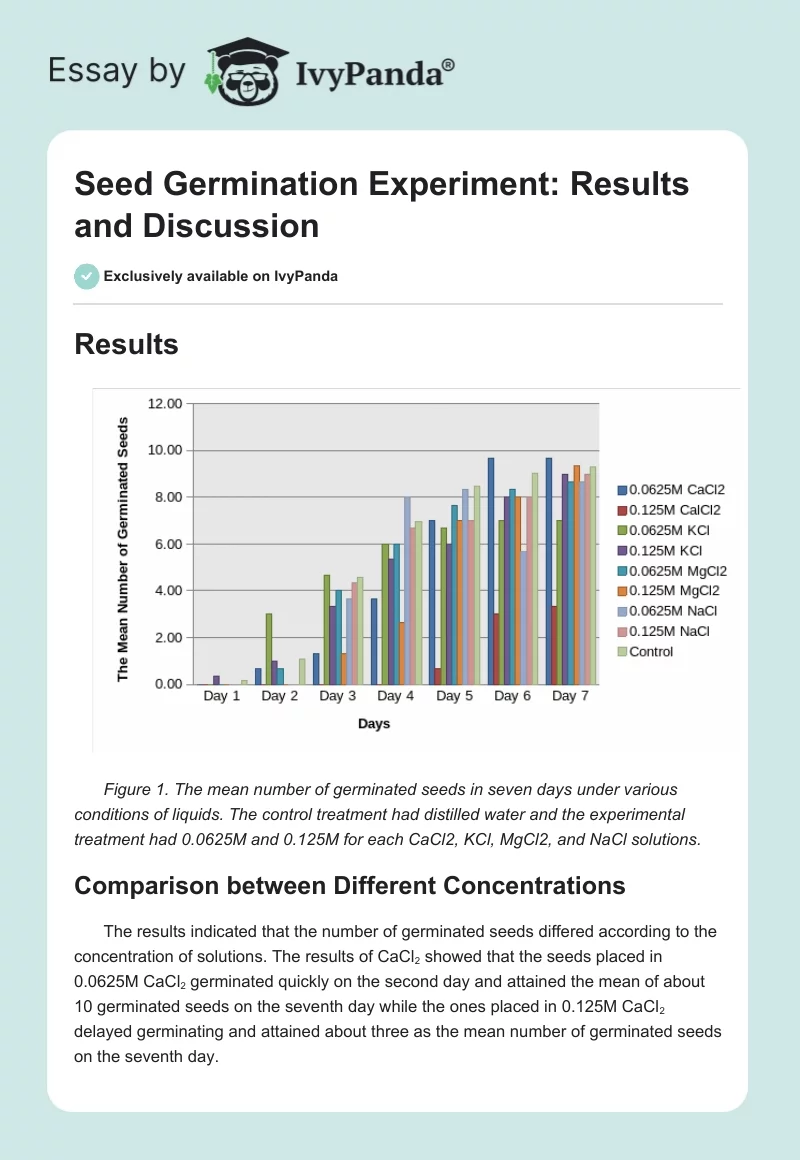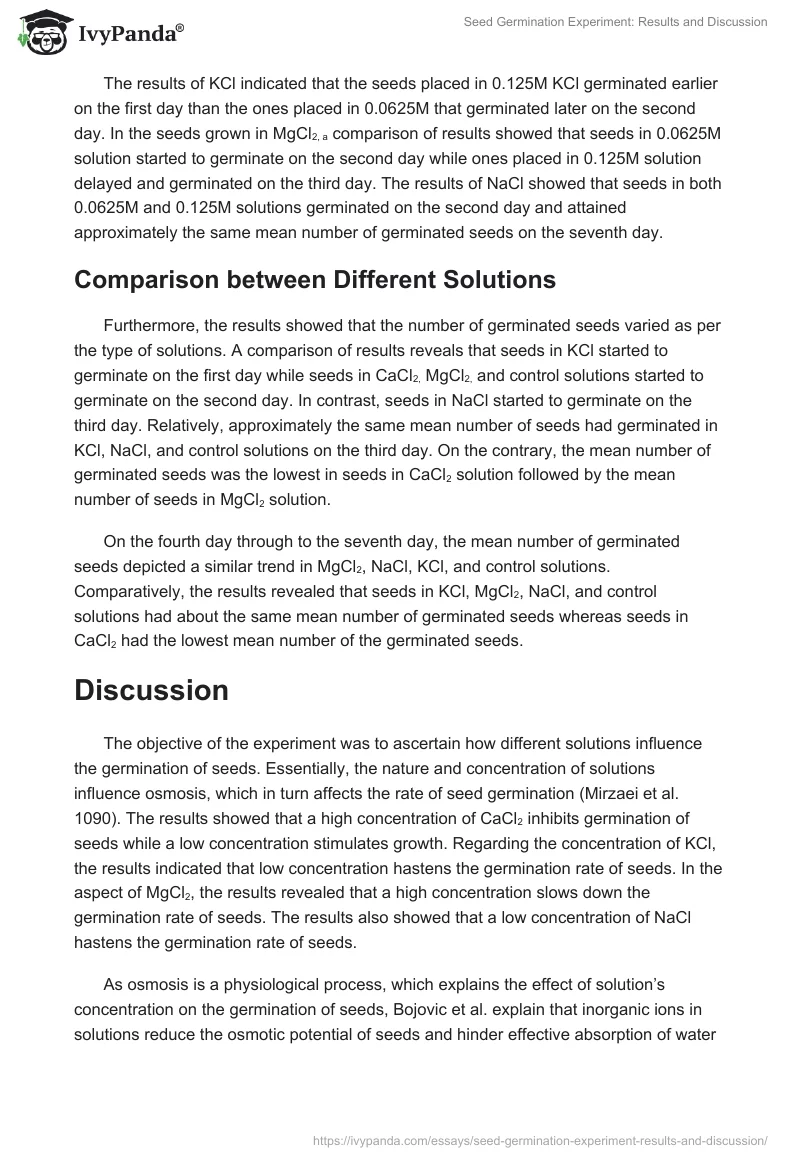Results

Comparison between Different Concentrations
The results indicated that the number of germinated seeds differed according to the concentration of solutions. The results of CaCl2 showed that the seeds placed in 0.0625M CaCl2 germinated quickly on the second day and attained the mean of about 10 germinated seeds on the seventh day while the ones placed in 0.125M CaCl2 delayed germinating and attained about three as the mean number of germinated seeds on the seventh day.
The results of KCl indicated that the seeds placed in 0.125M KCl germinated earlier on the first day than the ones placed in 0.0625M that germinated later on the second day. In the seeds grown in MgCl2, a comparison of results showed that seeds in 0.0625M solution started to germinate on the second day while ones placed in 0.125M solution delayed and germinated on the third day. The results of NaCl showed that seeds in both 0.0625M and 0.125M solutions germinated on the second day and attained approximately the same mean number of germinated seeds on the seventh day.
Comparison between Different Solutions
Furthermore, the results showed that the number of germinated seeds varied as per the type of solutions. A comparison of results reveals that seeds in KCl started to germinate on the first day while seeds in CaCl2, MgCl2, and control solutions started to germinate on the second day. In contrast, seeds in NaCl started to germinate on the third day. Relatively, approximately the same mean number of seeds had germinated in KCl, NaCl, and control solutions on the third day. On the contrary, the mean number of germinated seeds was the lowest in seeds in CaCl2 solution followed by the mean number of seeds in MgCl2 solution.
On the fourth day through to the seventh day, the mean number of germinated seeds depicted a similar trend in MgCl2, NaCl, KCl, and control solutions. Comparatively, the results revealed that seeds in KCl, MgCl2, NaCl, and control solutions had about the same mean number of germinated seeds whereas seeds in CaCl2 had the lowest mean number of the germinated seeds.
Discussion
The objective of the experiment was to ascertain how different solutions influence the germination of seeds. Essentially, the nature and concentration of solutions influence osmosis, which in turn affects the rate of seed germination (Mirzaei et al. 1090). The results showed that a high concentration of CaCl2 inhibits germination of seeds while a low concentration stimulates growth. Regarding the concentration of KCl, the results indicated that low concentration hastens the germination rate of seeds. In the aspect of MgCl2, the results revealed that a high concentration slows down the germination rate of seeds. The results also showed that a low concentration of NaCl hastens the germination rate of seeds.
As osmosis is a physiological process, which explains the effect of solution’s concentration on the germination of seeds, Bojovic et al. explain that inorganic ions in solutions reduce the osmotic potential of seeds and hinder effective absorption of water for germination purposes (83). Seeds grown in solutions germinate at a slower rate or fail to germinate when compared to seeds grown in distilled water.
The results demonstrated that seeds grown in the solutions of CaCl2 and MgCl2 with high concentration had slowed germination rate or inhibited germination when compared to other solutions. These findings are consistent with the findings of a study, which established that the inhibition effect was higher in the solutions with MgCl2 and CaCl2 when compared to solutions with NaCl and KCl (Panuccio et al. 5). The plausible explanation of the apparent observation is that divalent cations induce more osmotic stress than monovalent ions.
Moreover, from the results, it is apparent that seeds grown in different solutions did grow at different rates, but eventually achieved about the same number of germinated seeds. Rapid germination rate observed occurred because monovalent ions do not induce significant osmotic pressure on seeds, and thus, allowing them to imbibe water fast and germinate rapidly. In saline conditions, seeds take a long to germinate because the osmotic stress slows down the process of water imbibition resulting in the delayed breaking of dormancy (Demir and Mavi 899). Eventually, seeds manage to germinate even in the most saline environment because seeds imbibe water slowly until they get adequate amounts for breaking their dormancy.
According to other studies, the presence of cations, such as Mg2+, Na+, Ca2+, and K+, in water reduces the germination rate of seeds because they create physiological drought and prevent or delay seeds from breaking their dormancy (Abari et al. 53; Mirzaei et al. 1090; Zhang, Rue, and Wang 528). The findings of this study are similar to other studies because the design of the experiment ensured that the findings are valid and reliable. Therefore, the findings support the hypothesis that the rate of germination in seeds grown in solutions is slower than the rate of germination in seeds grown in distilled water.
As the experiment used two concentrations of a given solution and three replicates, the outcomes do not provide robust results. In this view, a follow-up experiment should expand the range of solutions, and the number of replicates to provide a clear trend of variation in the germination. Moreover, there is a possibility that the experimental design led to biased outcomes for each student recorded own data. Hence, a blinded study is appropriate to prevent researchers from introducing their biases into findings.
In conclusion, the experiment has demonstrated that a high concentration of CaCl2 and MgCl2 inhibits germination while a high concentration of KCl and NaCl slows down the rate of germination.
Works Cited
Abari, Akram, Mohammad Nasr, Mohammad Hojjati, and Dariush Bayat. “Salt effects on seed germination and seedling emergence of two Acacia species.” African Journal of Plant Science 5.1 (2011): 52-56. Web.
Bojovic, Biljana, Gorica Delic, Marina Topuzovic, and Milan Stankovic. “Effects of NaCl on seed germination in some species from families Brassicacea and Solanaceae.” Kragujavac Journal Science 32.1 (2010): 83-87. Web.
Demir, Ibrahim and Kazim Mavi. “Effect of salt and osmotic stresses on the germination of pepper seeds of different maturation stages.” Brazilian Archives of Biology and Technology 51.5 (2008): 897-902. Web.
Mirzaei, Amir, Rahim Naseri, Tahereh Emami, and Askar Jozeyan. “Effect of salinity on germination and seedling growth of bread wheat (Triticum aestivum L.).” International Journal of Agriculture and Crop Sciences 4.15 (2012): 1089-1091. Web.
Panuccio, Maria, Erik Jacobsen, Shoaib Akhtar, and Adele Muscolol. “Effect of saline water on seed germination and early seedling growth of the halophyte quinoa.” Annals of Botany Plants 6.47 (2014): 1-18. Web.
Zhang, Qi, Kevin Rue, and Sheng Wang. “Salinity effect on seed germination and growth of two warm-season native grass species.” Horticulture Science 47.4 (2012): 527-530. Web.


